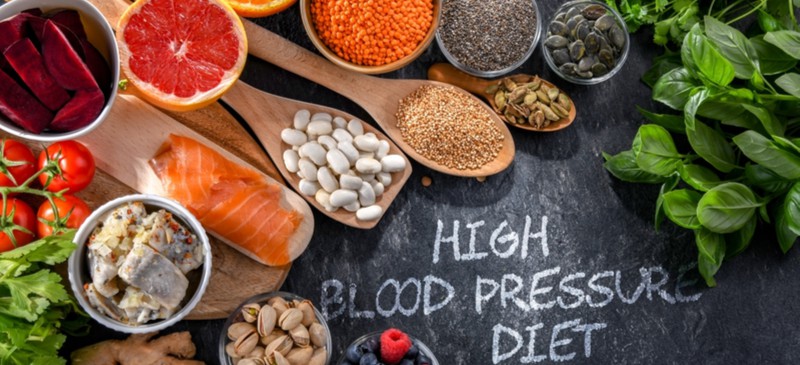Diet for High Blood Pressure
Before we delve into diet for high blood pressure, understand that hypertension, commonly known as high blood pressure, is a leading preventable risk factor for heart disease, affecting over a billion people globally.
It is diagnosed when systolic blood pressure (SBP)—the top number in a reading—reaches 130 mm Hg or higher, and/or when diastolic blood pressure (DBP)—the bottom number—exceeds 80 mm Hg. Managing high blood pressure is crucial for preventing cardiovascular complications.
Lifestyle adjustments, such as incorporating healthy dietary habits, can play a significant role in reducing blood pressure and lowering the risk of heart disease. In some cases, healthcare providers may prescribe medications, including angiotensin-converting enzyme (ACE) inhibitors, to help control blood pressure levels.
Along with medical treatments, consuming foods rich in potassium and magnesium has been shown to support healthy blood pressure regulation.
- Citrus Fruits
Citrus fruits like grapefruit, oranges, and lemons are not only refreshing but also packed with essential vitamins, minerals, and plant compounds that benefit heart health. These fruits can contribute to lowering blood pressure by addressing key risk factors associated with hypertension.
A comprehensive review in 2021 analyzed a decade of research on fruit consumption and its role in managing high blood pressure. The findings revealed that consuming approximately 530 to 600 grams of fruit daily—roughly the equivalent of four oranges—was associated with improved blood pressure levels.
In particular, citrus fruits have been linked to a reduced risk of developing high blood pressure, offering a natural and nutritious way to support cardiovascular health.
Drinking orange and grapefruit juice may also aid in lowering blood pressure; however, caution is necessary for individuals taking blood pressure medications. Grapefruit and its juice can interfere with certain drugs, so it’s advisable to consult a healthcare provider before adding these to your diet.
- Salmon and Other Fatty Fish
Fatty fish, such as salmon, mackerel, and sardines, are rich in omega-3 fatty acids, which have profound benefits for heart health, particularly in managing blood pressure. These healthy fats help reduce inflammation in the body, a key factor that can contribute to hypertension.
A significant study in 2022, analyzing 71 different studies involving 4,973 participants, showed that consuming 2 to 3 grams of omega-3 fats daily—equivalent to about a 3.5-ounce serving of salmon—was most effective in lowering blood pressure.
Omega-3 fatty acids are especially beneficial for young adults without a history of heart disease or diabetes, as they may help reduce the risk of developing high blood pressure.
- Leafy Greens
Leafy greens, such as Swiss chard and spinach, are excellent sources of nutrients like potassium and magnesium, both of which play critical roles in regulating blood pressure. For example, a cup of cooked Swiss chard contains about 20% of the daily recommended potassium intake and 36% of magnesium, making it a valuable addition to a heart-healthy diet.
A 2022 study revealed that for people with high sodium levels, every 1-gram increase in daily potassium intake was linked to a 2.4 mm Hg reduction in systolic blood pressure (SBP).
Spinach, rich in nitrates, is another leafy green that can positively impact blood pressure by promoting better blood vessel function. In a small study, participants who consumed high-nitrate spinach soup daily for a week experienced lower systolic and diastolic blood pressure compared to those who consumed low-nitrate asparagus soup. Although more recent studies have produced mixed results regarding the effectiveness of nitrate-rich leafy greens in reducing blood pressure, ongoing research is needed to clarify their potential benefits.
- Nuts and Seeds
Nuts and seeds are packed with fiber, healthy fats, and essential nutrients such as magnesium and arginine, an amino acid that supports the production of nitric oxide, which helps relax blood vessels and improve blood flow.
Some of the best options for supporting healthy blood pressure include pumpkin seeds, flaxseed, chia seeds, pistachios, walnuts, and almonds.
Several studies suggest a potential link between the regular consumption of nuts and seeds and lower blood pressure levels.
However, clinical research has produced mixed results, likely due to the relatively short duration of many of these studies. Longer, more comprehensive trials may provide clearer evidence of the relationship between nuts, seeds, and blood pressure control.
- Legumes
Legumes, which include lentils, beans, and peas, are packed with potassium, magnesium, and fiber, all of which are essential for maintaining healthy blood pressure levels. Observational studies have frequently indicated that diets rich in legumes may contribute to lower blood pressure.
However, a 2023 review of 16 clinical trials found no significant relationship between legume consumption and blood pressure reduction. Researchers suggest that larger, longer-term studies are needed to better understand the role legumes play in blood pressure management and how they may complement other dietary approaches for cardiovascular health.
- Berries
Berries are packed with antioxidants and are recognized for their impressive health benefits, including their ability to lower risk factors associated with heart disease, such as high blood pressure. One key antioxidant found in berries is anthocyanin, which gives these fruits their deep, vibrant colors.
Anthocyanins help to increase nitric oxide levels in the bloodstream, a compound that aids in relaxing blood vessels and improving blood flow, potentially reducing blood pressure. They also inhibit the production of harmful molecules that can restrict blood circulation. However, more human studies are needed to confirm the extent of these effects.
SEE ALSO: How to Reduce Itchy Eye
Various types of berries may contribute to lowering blood pressure, including:
- Blueberries
- Raspberries
- Chokeberries
- Strawberries
- Grapes
- Cranberries
A 2020 review of clinical studies found that consuming different forms of berries—whether whole, freeze-dried, or as juice—resulted in a reduction of systolic blood pressure (SBP) by over 3 mm Hg. Among these, cranberry juice showed the most significant impact on reducing SBP.
- Amaranth
Whole grains like amaranth are beneficial for heart health and can aid in lowering blood pressure. Studies suggest that diets rich in whole grains may significantly reduce the risk of developing high blood pressure.
In fact, a review of 28 studies concluded that for every 30-gram increase in daily whole grain consumption, there was an 8% reduction in the likelihood of high blood pressure.
Amaranth is particularly rich in magnesium, a vital mineral for blood pressure regulation. Just one cup of cooked amaranth (about 246 grams) provides 38% of the recommended daily intake of magnesium.
If amaranth is not readily available, other whole grains such as quinoa, whole oats, brown rice, whole grain bread, corn, and whole wheat pasta can serve as excellent alternatives, offering similar benefits for blood pressure control.
- Olive Oil
Olive oil, extracted from the fruit of the olive tree, is renowned for its numerous health benefits, particularly in relation to heart health and reducing blood pressure. This nutrient-dense oil is rich in omega-9 fatty acids, primarily oleic acid, and polyphenols—potent antioxidants that promote cardiovascular health.
A 2020 review found that incorporating olive oil into the diet can be an effective measure to reduce blood pressure, making it a beneficial addition to any heart-healthy diet.
- Carrots
Carrots, with their crunchy texture and sweet flavor, are packed with plant-based compounds that support various health benefits, including blood pressure management.
A 2023 study revealed that consuming approximately 100 grams of carrots daily (around 1 cup of grated raw carrots) was associated with a 10% reduction in the risk of developing high blood pressure. This makes carrots a nutritious and convenient option for supporting heart health.
- Eggs
Eggs are a nutrient-dense food that can be a beneficial component of a diet designed to manage blood pressure. A 2023 study involving 2,349 adults in the U.S. discovered that individuals who consumed five or more eggs per week had systolic blood pressure (SBP) levels that were 2.5 mm Hg lower than those who ate less than half an egg per week.
Moreover, regular egg consumption was linked to a significantly lower risk of developing high blood pressure over time. The latest research suggests that adults in good health can safely consume up to three eggs per day without negatively impacting other heart disease risk factors.
- Tomatoes and Tomato Products
Tomatoes, along with their products like tomato juice and sauce, are abundant in heart-healthy nutrients such as potassium and the antioxidant lycopene. Lycopene has been associated with several cardiovascular benefits, including the reduction of heart disease risk factors like high blood pressure.
A review of 21 studies concluded that consuming tomatoes and tomato products improved blood pressure and lowered the risk of heart disease. While some studies show inconsistent results, additional research is necessary to fully understand the link between tomatoes and blood pressure management.
- Broccoli
Broccoli is a cruciferous vegetable loaded with health benefits, particularly for cardiovascular health. Rich in flavonoid antioxidants, broccoli may help lower blood pressure by improving blood vessel function and boosting nitric oxide production in the body.
A large-scale study involving data from 187,453 people found that those who consumed four or more servings of broccoli per week had a lower risk of high blood pressure compared to those who consumed it less frequently.
- Yogurt
Yogurt, a nutrient-dense dairy product, is a great source of essential minerals like potassium and calcium, which are key to regulating blood pressure. A review of 28 studies showed that consuming three servings of dairy per day was linked to a 13% lower risk of developing high blood pressure.
Additionally, a 2021 study indicated that people with high blood pressure who consumed yogurt daily had lower systolic blood pressure levels. Increasing yogurt intake may provide a modest reduction in blood pressure, especially for those already managing hypertension.
- Herbs and Spices
Certain herbs and spices are rich in powerful compounds that may aid in lowering blood pressure by helping to relax blood vessels. Examples include:
- Celery seed
- Cilantro
- Saffron
- Lemongrass
- Garlic
- Ginger
- Cinnamon
A 2021 study with 71 participants found that consuming 6.6 grams of a combination of 24 different herbs and spices daily for four weeks resulted in significant reductions in blood pressure, compared to lower dosages.
- Potatoes
Potatoes, often overlooked, are an excellent source of potassium—a key nutrient for blood pressure regulation. A medium baked potato with the skin provides 941 milligrams of potassium, more than 20% of the daily recommended intake and surpassing the potassium content of a banana.
A 2021 study involving 30 adults with high blood pressure found that a diet including potatoes led to significant reductions in systolic blood pressure as part of an overall potassium-rich diet.
- Kiwifruit
Kiwifruit is rich in vitamin C, fiber, potassium, and magnesium—all nutrients that help regulate blood pressure. Additionally, it contains polyphenols and antioxidants that support heart health.
A 2022 study of healthy Asian adults found that eating two kiwifruits for breakfast over a seven-week period lowered systolic blood pressure by 2.7 mm Hg compared to those who did not eat the fruit. Further research is needed to explore the long-term effects of kiwifruit on blood pressure.
- Lean Meats
Lean meats, defined by the USDA as meats with less than 10 grams of total fat, can be part of a balanced diet for lowering blood pressure. Examples of lean meats include:
- Skinless chicken breast
- Beef sirloin
- Pork tenderloin
- 93% lean ground turkey
An older study found that substituting lean pork for chicken or fish in a modified DASH (Dietary Approaches to Stop Hypertension) diet for six weeks led to comparable reductions in blood pressure. Research from China also suggests that a diverse protein intake—including lean meats—can significantly lower the likelihood of developing high blood pressure.
Insights on Diet for High Blood Pressure
What you eat has a significant impact on your blood pressure and overall well-being. Making the right dietary choices can help prevent or manage high blood pressure, but with so much information out there, it’s easy to feel overwhelmed.
For example, too much salt can increase your blood pressure, but how can you tell if you’re consuming more than you should? While eating the recommended five servings of fruits and vegetables daily can lower your blood pressure, fitting that into your routine might seem like a challenge.
To help clear the confusion, here’s a guide on the types of foods and nutrients that influence blood pressure, along with simple tips to naturally lower it. Eating healthily doesn’t have to be complicated, expensive, or boring—it can be simple, affordable, and enjoyable!
Salt
Excessive salt intake is one of the biggest culprits for raising blood pressure, but it’s not always obvious how much you’re consuming because it’s often hidden in processed and packaged foods. Learn practical ways to cut back on salt while still enjoying flavorful meals.
Fruits and Vegetables
Fruits and vegetables are well-known for their health benefits, but did you know they can actively help reduce blood pressure? Discover how these nutrient-packed foods work to support your heart and how you can easily incorporate more into your daily diet.
Fats and Cholesterol
The amount and type of fat in your diet play a crucial role in heart health. Consuming too much saturated fat can raise cholesterol levels and lead to artery blockages, which may increase your risk of high blood pressure. Find out how to reduce unhealthy fats while still enjoying a varied diet.
Sugar
High sugar intake contributes to weight gain, which can lead to increased blood pressure. Learn how to minimize added sugars in your diet, making it easier to maintain a healthy weight and keep your blood pressure in check.
Potassium
Potassium is a key mineral that helps balance sodium in the body and lowers blood pressure. Discover easy ways to increase your potassium intake through foods like bananas, potatoes, and leafy greens.
Understanding Food Labels
Food labels can be tricky, but learning how to read them will empower you to make better choices for maintaining healthy blood pressure. Find out what to look for to ensure your diet supports heart health.
Blood Pressure-Friendly Foods
Stocking your kitchen with the right foods can make a world of difference for your blood pressure. Explore a list of essential items to keep in your fridge and pantry that will help you stay on track with your blood pressure goals.
Delicious and Healthy Recipes
Eating healthily doesn’t mean sacrificing flavor. Browse through our collection of heart-friendly recipes that are not only nutritious but also delicious, helping you enjoy meals while taking care of your blood pressure.
If You’re from an African Caribbean or South Asian Background
Your ethnic background can influence your risk of developing high blood pressure. If you’re from an African Caribbean or South Asian heritage, find out how making tailored dietary changes can help reduce your risk and improve your heart health.
By making small, thoughtful adjustments to your eating habits, you can take significant steps toward controlling your blood pressure and improving your overall health.

A graduate of Computer Science and Information Management Technology. Diploma – Caregiving, Certificates – Dementia and Diabetes Awareness and Management. A researcher, blogger, songwriter, singer and acoustic guitarist. Born in an environment where natural talents such as healing are imparted at our natural birth. This natural talents of healing is the result of our genetic inheritance and the training from family environment.



















